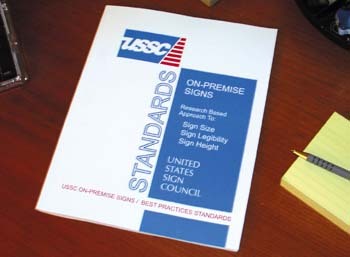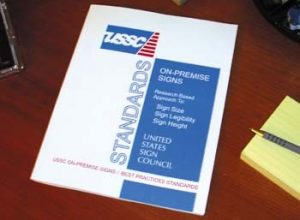As a follow-up to its four, previous, sign-visibility studies, the United States Sign Council (USSC), Bristol, PA — in collaboration with its research arm, the United States Sign Council Foundation (USSCF), and the Pennsylvania Transportation Institute — has published its findings pertaining to on-premise sign size, legibility and height. Titled USSC Best Practices Standards, the 39-page publication uses tables, charts and mathematical formulae to determine on-premise sign standards necessary for achieving effective roadside communication and maintaining traffic safety.
According to the study, as a driving task’s or landscape’s complexity increases, detection of specific objects within the landscape decreases, meaning signage needs to be more conspicuous for easy detection. Because a motorist’s cone of vision extends 10° to either side, "head-on" or perpendicular views are easier to detect than parallel or side-oriented views. Thus, to assure optimal initial detection within a driver’s cone of vision, a sign should be located as close to a roadside as possible.
Current research also suggests that drivers need approximately four seconds to comfortably read and comprehend signs comprising four to eight words and simple typography. This yields a reading time, or "message scan," of one-half second per word. Familiar symbols, logos or icons are equivalent to one word, or five letters, and yield the same reading time. Conversely, unfamiliar symbols require more time for interpretation. Table 1: Viewer Reaction Time Computation
Driving Environment
Task Simple Complex* Multi-Lane**
Detection 0.5 seconds 1 second 1 second
Message Scan 0.1 seconds/letter 0.1 seconds/letter 0.1 seconds/letter
0.5 seconds/symbol 0.5 seconds/symbol 0.5 seconds/symbol
Re-orientation 0.02 seconds/letter 0.04 seconds/letter 0.04 seconds/letter
Scan 0.1 seconds/symbol 0.2 seconds/symbol 0.2 seconds/symbol
Maneuver 4 seconds 5 seconds 6 seconds
*Developed town or city commercial areas. Single- or multi-lane travel under 35 mph.
**Developed urban/suburban commercial areas. Multi-lane travel over 35 mph.
In addition, the publication notes that copy area and negative space are critical components of effective sign design. To provide reasonable legibility, a sign’s copy area, which includes its lettering and spaces in between (letterspace), should comprise 40% of the total sign-panel area, with the remaining 60% forming the sign’s negative space (open space) that surrounds the copy.
Finally, the study addresses sign-height recommendations and sign-blocking scenarios, which the association covered in depth in its last sign-visibility study, Effects of Traffic Characteristics and Mounting Height (see ST, August 2003, page 82). Based on its research, the USSC recommends a minimum height standard of 7 ft. above grade for signs placed on four-lane, undivided highways. If a sign is situated at or below 5 ft. above grade, other vehicles may block a motorist’s view of the sign’s copy. Thus, the association suggests raised sign height as the best solution to this problem. $image1
Advertisement
Area of Sign/Computation Process
To determine this example’s sign-area calculation, researchers considered an internally illuminated sign comprising black, upper- and lower-case Clarendon letters on a white background. The sign is located in a complex driving environment with a posted traffic speed of 40 mph.
1. Determine speed of travel (mph) in ft. per second (FPS): 40 mph x 1.47 = 59 FPS
2. Determine viewer reaction time (VRT) (Refer to Table 1): Detection (complex environment) = 1 second Message scan: 23 letters x 0.1 seconds = 2.3 seconds Re-orientation scan: 23 letters x 0.04 seconds = 0.92 seconds Maneuver = 5 seconds Total VRT (rounded) = 9 seconds
3. Determine viewer reaction distance: 59 FPS x 9 VRT = 531 ft.
4. Determine letter height in inches by referring to the legibility index (LI) Table 2: Black Clarendon letters on white background = index of 31; 531 (VRD) divided by 31 (LI) = 17-in. letter height.
Advertisement
5. Determine single-letter area in square inches: 17 x 17 = 289 sq. in.
6. Determine single-letter area in square feet: 289 divided by 144 = 2 sq. ft.
7. Determine copy area: single-letter area (2 sq. ft.) x number of letters (23) = 46 sq. ft.
8. Determine negative space at 60% of copy area: 46 x 1.5 = 69 sq. ft.
9. Add copy area to negative space: 46 + 69 = 115 sq. ft.
10. Result is area of sign: 115 sq. ft.
Advertisement
Table 2: The USSC Standard Legibility Index
Illumination Letter Style Letter Color Background Color Upper and Lower Case All Cap
External Helvetica Black White 29 25
External Helvetica Yellow Green 26 22
External Helvetica White Black 26 22
External Clarendon Black White 28 24
External Clarendon Yellow Green 31 26
External Clarendon White Black 24 20
Internal Helvetica Black White 29 25
Translucent Internal Helvetica Yellow Green 37 31
Translucent Internal Clarendon Black White 31 26
Translucent Internal Clarendon Yellow Green 37 31
Translucent Internal Opaque Helvetica White Black 34 29
Internal Opaque Helvetica Yellow Green 37 31
Internal Opaque Clarendon White Black 36 30
Internal Opaque Clarendon Yellow Green 37 28
Neon Helvetica Red Black 29 25
Neon Helvetica White Black 38 32
Note: To use the table to determine letter height for any given viewing distance, select the illumination, letter style and color, and background color that most closely resembles the sign being evaluated. Divide the viewing distance (in feet) by the appropriate legibility index value. The result is the letter height (in inches) for the initial capital letter in upper- and lower-case configurations, or for every letter in an all-caps configuration.



 Tip Sheet1 week ago
Tip Sheet1 week ago
 Photo Gallery3 days ago
Photo Gallery3 days ago
 Ask Signs of the Times4 days ago
Ask Signs of the Times4 days ago
 Real Deal2 weeks ago
Real Deal2 weeks ago
 Benchmarks1 week ago
Benchmarks1 week ago
 Women in Signs2 weeks ago
Women in Signs2 weeks ago
 Photo Gallery1 week ago
Photo Gallery1 week ago
 Women in Signs1 week ago
Women in Signs1 week ago










